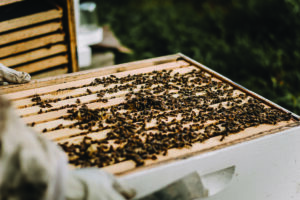
After catching a swarm of bees not a new hive, beekeepers carefully manage the insects, allowing it to double in size. (Photo courtesy Rachel Stevens)
The sight of thousands of honey bees clustered together on a fence post or side of a house with more bees buzzing around it can be pretty intimidating to the untrained eye. But for beekeepers, it’s akin to a winning raffle ticket.
This swarm of bees happens if their previous hive became too crowded or disease or other disturbance sent them looking for a new home. It can happen under a car fender, on a chain link fence, on a tree branch, the eave of a house or any number of other places the thick cloud of bees decides to stop and rest.
When out in the open, a swarm is almost always temporary, said Cape Charles, Va., beekeeper Rachel Stevens.
“If you just leave them alone, they’ll probably just go off and find their chosen home,” she said. But a trained beekeeper can “catch” the swarm and raise it into a full colony, more than double it’s size.
“There’s no reason to be scared because they’re pretty mellow when they’re in a swarm,” Stevens said.
Stevens said she normally hears about swarms more in July but this year, it seems to have started earlier and, posting on social media, she urged people that see a swarm to call her or another local beekeeper to get it removed rather than an extermination service.
With only a few days of a window to get the bees before they move on to another spot, Stevens said it’s important to know a beekeeper to contact who would catch it or know of someone who would. Some beekeepers are leery about catching swarms above a certain height while others are more eager or have access to equipment to reach higher.
Either way, contacting a beekeeper first is Stevens’ and other beekeepers’ advice.
Beekeeper groups on the Eastern Shore include the Lower Eastern Shore Beekeepers, lowereasternshorebeekeepers.org, the Beekeepers Guild of The Eastern Shore, bgesva.org, Wye River Beekeepers, wyeriverbeekeepers.org and the Upper Eastern Shore Beekeepers Association, uesbees.org.



